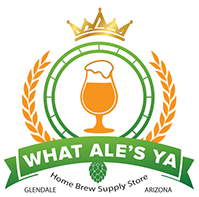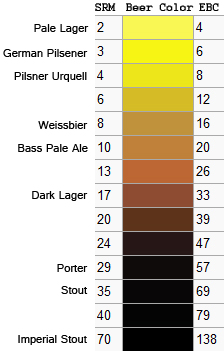

Brewing
What is SRM or Standard Reference Method?
Standard Reference Method
The Standard Reference Method or SRM is a method to objectively quantify the darkness of a beer or malted grain. Note that the SRM is a simple numeric value, and cannot be used to describe or determine the hue or tint of a beer or malt, only it’s darkness.

What is IBU or International Bittering Units?
The International Bittering Units scale, or simply IBU scale, provides a measure of the bitterness of beer, which is provided by the hops used during brewing. Bittering units are measured through the use of a spectrophotometer and solvent extraction.
This technique was adopted at the same time as another method based on measuring the concentration (in milligrams per liter; parts per million w/v) of isomerized α acids in a beer, causing some confusion among small-scale brewers. The American Society of Brewing Chemists, in the introduction to its methods on measuring bitterness, points out some differences between the results of the two methods:
While the results of the IAA [isomerized α acids] methods are practically identical to those obtained by the IBU method for beer brewed with fresh hops, the IAAs of beer brewed with old or poorly stored hops, and with certain special hop extracts, can be significantly lower than the IBU figure.
The bittering effect is less noticeable in beers with a high quantity of malt, so a higher IBU is needed in heavier beers to balance the flavor. For example, an Imperial Stout may have an IBU of 50, but will taste less bitter than an English Bitter with an IBU of 30, because the latter beer uses much less malt than the former. The technical limit for IBU’s is around 100; some have tried to surpass this number, but there is no real gauge after 100 IBUs when it comes to taste threshold. Light lagers without much bitterness will generally have 5 IBUs, while an India Pale Ale may have 100 IBUs or more.
Kegging
How often do I have to have my CO2 Bottle pressure tested?
CO2 Bottles must be tested every FIVE years.
What Ale’s Ya refills CO2 bottles with beverage grade CO2 but we do not provide pressure testing on site but we can get them done for you. We tend to try and go down once a month and it takes them 1 week to complete.
What do you recommend for force carbonation?
Easy Answer - 30 PSI for 24 to 40 Hours at 35°F
From Shaking your keg to rolling it on the ground there are a lot of different ways to get Co2 into your Beer. We recommend setting your regulator to 30psi and letting your beer sit for 24 to 40 hrs.
After 24hr take a sample of your beer and see if you like the carbonation if not turn it back up and let it sit longer.
DO NOT LEAVE YOUR BEER AT HIGH PRESSURE FOR OVER 40hrs WITHOUT TRYING IT. YOU WILL OVER CARB IT AND WILL HAVE NOTHING BUT FOAM.
Now your beer will not start to absorb Co2 until it is around 35F.
Have a question you want answered fill out the form and we will get back to you ASAP








